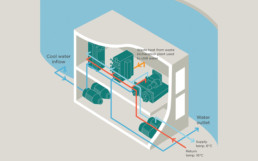The City of Gothenburg in Sweden uses a district cooling system powered by the cool flows from the river Göta älv.
Gothenburg, Sweden, uses the river Göta älv to pre-cool water used in its large-scale district cooling system. By using a combination of river water for pre-cooling and waste heat from an incineration plant to drive its absorption chillers, Gothenburg substantially lowered CO2 emissions compared to conventional cooling methods. Customers get the environmental benefit of sustainable cooling at an affordable cost.

Why you should care
Gothenburg’s district cooling system harnesses free, local resources – river water and surplus heat – in order to offer citizens a cost-competitive, energy-efficient alternative to conventional air-conditioning in the summer. District cooling in Gothenburg is a sustainable way of providing a solution for a growing cooling domestic and industrial market.
How the Global Goals are addressed
![]() Affordable and clean energy
Affordable and clean energy
Using naturally cool river water is a clean and affordable source of energy for district cooling.
![]() Sustainable cities and communities
Sustainable cities and communities
Cities that use district cooling instead of air conditioning units for each building will save on costs and emissions.
![]() Climate action
Climate action
District cooling is estimated to reduce CO2 emissions by up to 80% compared to conventional air-conditioning.

The City of Gothenburg
View profile

